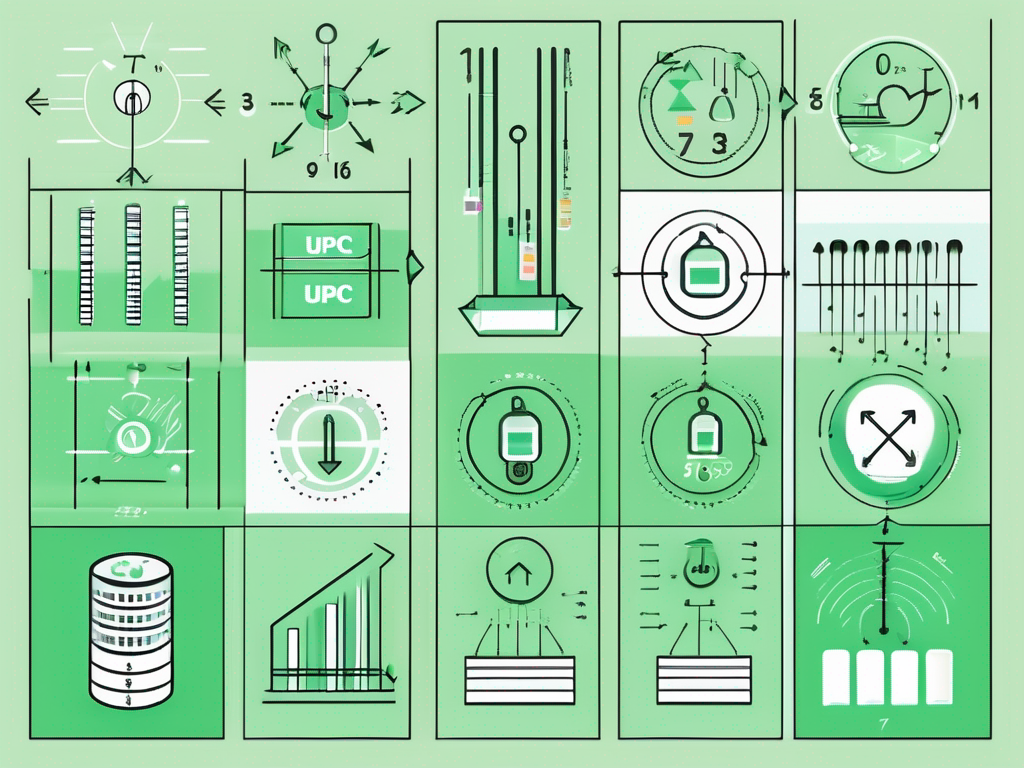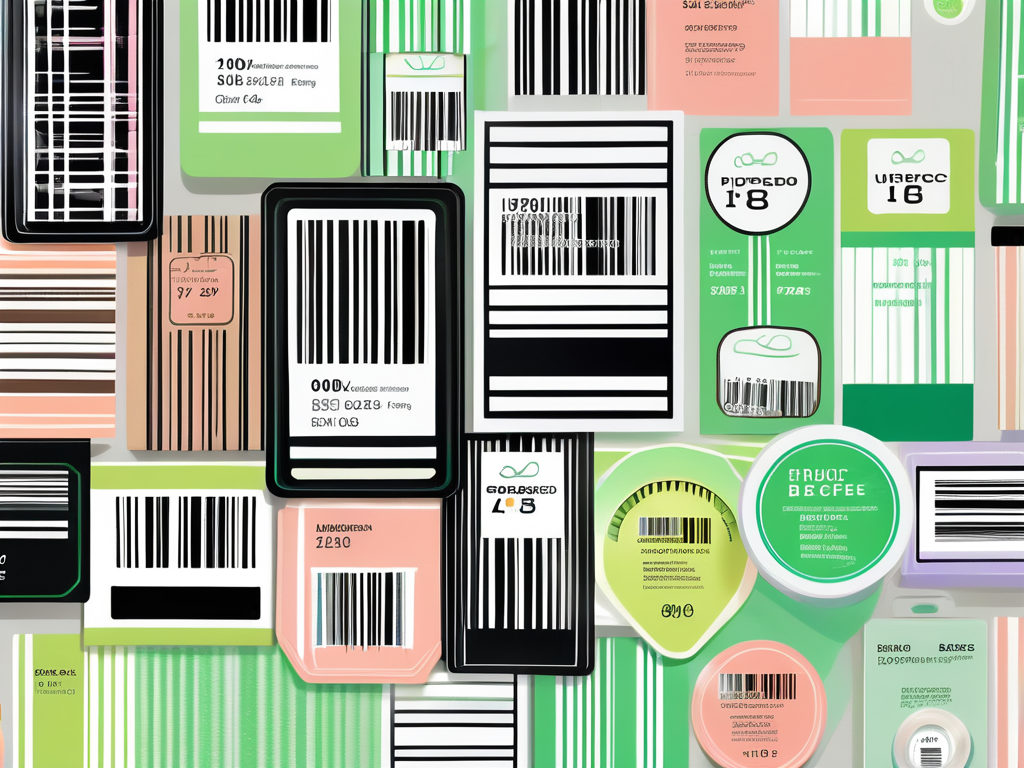Share this
UPC Symbols Decoded: What They Are and Why They’re Essential
by Shipfusion Team on Feb. 5, 2025

UPC symbols are integral to the modern retail ecosystem, facilitating various processes from inventory management to consumer purchases. This guide aims to provide a thorough understanding of UPC symbols, elucidating their structure, types, and practical applications in both physical and online retail settings.
The Basics of UPC Symbols
UPC, or Universal Product Code, is a barcode symbol used primarily for tracking trade items in stores. These symbols have become universally recognizable and are essential in streamlining product transactions. A UPC symbol consists of a unique 12-digit code assigned to each product, enabling retailers to ring up items at checkout and efficiently manage inventory.
What Is a UPC Symbol?
A UPC symbol is a series of vertical bars and numbers that represent product information in a machine-readable format. The barcode itself typically comprises 12 digits, with the first six digits identifying the manufacturer, the next five representing the specific product, and the last digit serving as a checksum to verify the code's accuracy. This formatting allows for easy scanning in retail environments. The design of the UPC symbol is standardized, ensuring that it can be read by any barcode scanner, regardless of the brand or model, which adds to its versatility and reliability across various retail settings.
The Importance of UPC Symbols
These symbols streamline operations in many ways. For retailers, UPC symbols help automate the checkout process, significantly reducing human error during transactions. They enhance inventory visibility, as each scan updates stock levels instantly, thereby improving supply chain efficiency. Moreover, they facilitate better customer experiences by reducing wait times at checkout.
In addition to these benefits, UPC symbols also play a crucial role in data collection and analysis. Retailers can track sales trends and inventory turnover rates, allowing them to make informed decisions about product placement, promotions, and restocking strategies. This data-driven approach not only optimizes inventory management but also helps in understanding consumer behavior, paving the way for targeted marketing efforts.
The Structure of UPC Symbols
The structure of UPC symbols may appear simple at first glance, yet it is intricately designed to serve multiple functions. Understanding this design is key to appreciating how UPC symbols work within a broader context.
The Anatomy of a UPC Symbol
A typical UPC-A barcode consists of 12 digits, formatted in a combination of bars and spaces. The digits are divided into components as follows: the first digit denotes the product category, the next five represent the manufacturer, the subsequent five digits identify the product itself, and the last digit is a checksum, aimed at ensuring accuracy. The combination of these components allows for the unique identification of each product. This structured approach not only facilitates inventory management but also enhances the speed of checkout processes in retail environments, making it a vital component of modern commerce.
Decoding the Numbers in UPC Symbols
Understanding the digits in a UPC symbol can provide valuable insights into a product. For instance, the first number can indicate the type of item, such as a grocery product, electronics, or apparel. The manufacturer's identification segment aids in tracing back product origins, which is especially useful in cases of recalls or quality control issues. The checksum digit serves as a security measure, enabling electronic systems to detect scanning errors.
Moreover, UPC symbols are not just limited to physical products; they are increasingly being integrated into digital platforms, allowing for seamless online shopping experiences where consumers can quickly access product information, reviews, and even pricing history just by scanning a code. This evolution underscores the importance of UPC symbols in both traditional and digital marketplaces, bridging the gap between physical and virtual retail spaces.
Types of UPC Symbols
UPC symbols are not one-size-fits-all; there are variations designed for different situations and requirements. The two primary types are UPC-A and UPC-E symbols, each tailored to specific needs in retail environments.
UPC-A Symbols
The UPC-A code is the most commonly used barcode format in North America. It features a 12-digit structure that allows retailers to uniquely identify products across a wide array of categories. This format is utilized by most grocery stores and retail establishments, making it essential for product tracking and management.
The first digit of the UPC-A code often indicates the type of product or the manufacturer, providing a quick reference for retailers and inventory systems. Furthermore, the UPC-A barcode is designed to be scanned quickly and accurately, which is crucial during high-volume sales periods, such as holidays or promotional events. Retailers rely heavily on this format to streamline their checkout processes and maintain accurate inventory levels.
UPC-E Symbols
UPC-E codes are an abbreviated version of UPC-A, designed for smaller packaging. This format compresses the barcode to a 6-digit number, which retains the essential information while occupying less space. UPC-E is often found on items like travel-size toiletries or products sold in limited quantities, where space is at a premium. The ability to condense the information without losing critical data makes UPC-E particularly valuable for manufacturers looking to optimize ecommerce packaging design.
Additionally, UPC-E codes can be converted back to UPC-A codes when necessary, allowing for flexibility in inventory management and retail environments. This adaptability ensures that even the smallest products can be efficiently tracked and sold, maintaining the integrity of the supply chain.
How UPC Symbols are Used in Retail
The integration of UPC symbols into retail operations has revolutionized how businesses manage and sell products. Retailers utilize these codes in various ways to improve efficiency, accountability, and customer service.
Inventory Management and UPC Symbols
Using UPC symbols for inventory management has become a standard practice in modern retail. Each scan at the point of sale updates the inventory database, allowing for real-time tracking of stock levels. This capability enables retailers to quickly assess when to reorder products and helps in minimizing overstock and stockouts. For example, if a particular brand of cereal sells quickly, retailers can reorder it efficiently, ensuring steady availability for customers. Moreover, the data collected through UPC scanning can reveal trends in consumer behavior, such as seasonal preferences or the popularity of specific items, which can inform future purchasing decisions and marketing strategies.
Pricing and UPC Symbols
Additionally, UPC symbols play an important role in pricing strategies. When a product is scanned at the register, the associated price is retrieved from the retailer's database. This not only streamlines transactions but also allows retailers to easily adjust pricing based on market trends or promotional discounts.
For instance, during holiday sales, prices can be quickly updated across thousands of products, ensuring customers always receive the correct pricing without manual intervention. Furthermore, UPC symbols facilitate dynamic pricing models, where prices can be adjusted in real-time based on demand fluctuations, competitor pricing, or inventory levels, enhancing the retailer's ability to maximize profits while remaining competitive in the marketplace.
Customer Experience and UPC Symbols
Beyond inventory and pricing, UPC symbols significantly enhance the overall customer experience. With the rise of self-checkout systems, customers can scan items themselves, making the checkout process faster and more convenient. This not only reduces wait times but also empowers customers to take control of their shopping experience.
Additionally, UPC codes can be integrated with loyalty programs, allowing retailers to track customer purchases and tailor promotions based on individual shopping habits. This personalized approach fosters customer loyalty and encourages repeat business, as shoppers are more likely to return to stores that recognize and reward their preferences.
Data Analytics and UPC Symbols
Moreover, the data generated from UPC scans goes beyond immediate sales and inventory management; it serves as a treasure trove for data analytics. Retailers can analyze purchasing patterns, peak shopping times, and product performance over time. This analysis can lead to informed decisions about product placement, marketing campaigns, and even store layout.
For example, if data indicates that certain products sell better when placed near complementary items, retailers can adjust their displays accordingly, optimizing the shopping experience and increasing sales. The strategic use of UPC symbols thus not only supports operational efficiency but also drives a deeper understanding of customer behavior and market dynamics.
The Role of UPC Symbols In Ecommerce
In the burgeoning world of ecommerce, UPC symbols hold significant relevance. Their application extends beyond brick-and-mortar stores and plays a crucial role in online transactions and product identifications within digital marketplaces.
Online Shopping and UPC Symbols
When customers shop online, UPC symbols assist both retailers and buyers in finding specific products. Many ecommerce platforms utilize these codes to maintain catalog integrity and ensure accurate product descriptions. By searching for a UPC code, customers can easily locate the exact item they wish to purchase without confusion. This not only streamlines the shopping experience but also reduces the likelihood of purchasing incorrect items, which can lead to dissatisfaction and returns.
Moreover, UPC symbols enhance the searchability of products across various online platforms. With the rise of comparison shopping engines and aggregator websites, having a unique UPC code allows products to be easily indexed and compared, giving consumers the power to make informed purchasing decisions. This transparency is vital in a competitive market where consumers are often overwhelmed by choices.
UPC Symbols and Product Identification Online
For online retailers, UPC symbols serve as a reliable method for product identification. Each listed item can be tagged with its unique UPC, enabling easy inventory tracking and management. This practice aids in maintaining consistency across platforms, ensuring that similar items are correctly categorized. In case of product returns or exchanges, UPC codes allow for swift processing, enhancing customer satisfaction. Retailers can quickly scan UPC codes to verify product details, which is particularly beneficial during peak shopping seasons when efficiency is paramount.
Additionally, UPC symbols play a crucial role in preventing fraud and counterfeit products in the e-commerce space. As online shopping continues to grow, so does the risk of encountering fake or substandard items. By relying on UPC codes, retailers can authenticate products and provide consumers with confidence in their purchases. This trust is essential for building long-term customer relationships and fostering brand loyalty in a landscape where consumers have endless options at their fingertips.
See UPC Symbols In Use at Shipfusion
A well-organized UPC system ensures smoother inventory management, better visibility across sales channels, and stronger retail partnerships. Whether you’re launching a new product line or expanding to brick-and-mortar stores, accurate UPCs are essential - and so is a reliable logistics system.
Shipfusion’s advanced lot tracking and inventory management tools use the UPS system to streamline fulfillment operations at scale. Contact us today to see how the right technology-backed partner can make all the difference during periods of rapid growth.
Share this
You May Also Like
These Related Articles

SKU vs UPC: Breaking Down the Differences

Product UPC Barcode: What It Is and Why It Matters In Ecommerce

The Ultimate Guide to EDI for Ecommerce
- April 2025 (18)
- March 2025 (26)
- February 2025 (26)
- January 2025 (37)
- December 2024 (16)
- November 2024 (23)
- October 2024 (22)
- September 2024 (27)
- August 2024 (9)
- July 2024 (8)
- June 2024 (5)
- May 2024 (8)
- April 2024 (8)
- March 2024 (6)
- February 2024 (6)
- January 2024 (5)
- December 2023 (3)
- November 2023 (3)
- October 2023 (5)
- September 2023 (4)
- August 2023 (2)
- July 2023 (1)
- June 2023 (4)
- March 2023 (2)
- October 2022 (1)
- September 2022 (5)
- August 2022 (4)
- July 2022 (7)
- June 2022 (4)
- May 2022 (4)
- April 2022 (6)
- March 2022 (2)
- February 2022 (1)
- January 2022 (3)
- December 2021 (2)
- November 2021 (4)
- October 2021 (2)
- September 2021 (5)
- August 2021 (4)
- July 2021 (4)
- June 2021 (3)
- May 2021 (2)
- April 2021 (3)
- March 2021 (3)
- February 2021 (3)
- January 2021 (2)
- December 2020 (4)
- November 2020 (2)
- October 2020 (4)
- September 2020 (2)
- July 2020 (5)
- June 2020 (4)
- May 2020 (2)
- April 2020 (2)
- March 2020 (4)
- February 2020 (1)
- December 2019 (1)
- May 2018 (1)
- March 2018 (2)
- February 2018 (3)
- January 2018 (3)
- November 2017 (3)
- July 2017 (4)
- March 2017 (3)
- February 2017 (5)
- January 2017 (3)
- December 2016 (4)
- November 2016 (6)
- October 2016 (6)
- October 2015 (1)
- September 2015 (1)
- June 2015 (3)
- May 2015 (3)
- August 2014 (1)
- July 2014 (1)
- March 2014 (1)
- February 2014 (1)